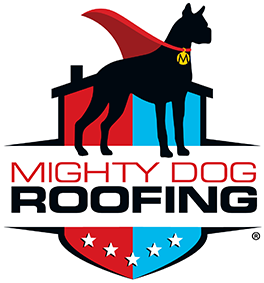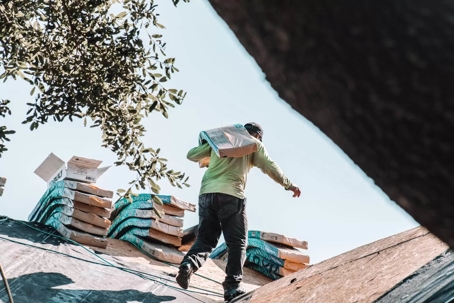What is Roof Underlayment? Synthetic vs. Felt
Protect your home with confidence!
Roofing underlayment is a roof component that roofers install between the shingles and roof deck, or roof sheathing. It provides a secondary line defense against the elements, like rain, sleet, snow, hail, and wind.
The underlayment on top of a roof deck will consist of synthetic felt, asphalt-saturated, or rubberized asphalt. An underlayment protects your home by keeping the area dry. It acts as a shield against leaks and rough weather.
Types Of Roofing Underlayment
There are multiple options for roofing underlayment types, but let's focus on the three popular ones: synthetic felt, asphalt-saturated, and rubberized asphalt underlayment.
Synthetic Roof Underlayment
Roofing contractors often use non-bitumen, synthetic underlayment made of synthetic felt. We reinforce these types of underlayments by incorporating fiberglass and laying down a synthetic base layer soaked in asphalt to enhance its strength and tear resistance.
Some of the best synthetic roofing underlayment options possess an extra layer of coarse woven material or scrim to make them less slippery, even when wet. Synthetic felt without bitumen has exceptional flexibility, waterproofing capabilities, durability, and resistance to mold.
Synthetic roofing underlayment is lighter than rubberized asphalt. Moreover, it effectively withstands UV rays and fungus, contributing to its long-lasting durability.
Durability
Synthetic felt does not get damaged easily or wear out quickly. With exceptional durability, this roofing underlayment offers a sturdy barrier that withstands heavy rain, strong winds, and intense temperatures without compromising effectiveness. This durability ensures long-term safety for your entire roof and all occupants.
Light Weight
The lightweight nature of synthetic underlayment makes it more manageable for roofers, reducing physical strain and promoting a quicker, more efficient installation. Also, the lightweight synthetic underlayment puts less pressure on your roof deck, which improves your roofing system's overall strength and lifespan.
Moisture Resistance
High-quality synthetic underlayment will prevent water or moisture from penetrating your roof, keeping the underlying structure dry and well-protected. This moisture resistance safeguards your roof against water damage like leaks or rot, which compromise your roof's integrity.
Cost
Synthetic roofing underlayment commands a higher price than traditional felt. However, its durability and performance justify the additional investment.
Slippery Surface
The smooth surface of synthetic underlayment makes it slippery during roof installation, requiring extra caution when working on steep roofs.
Pros
- Resilience
- Lightweight
- Water resistance
Cons
- Higher price
- Slick surface
Asphalt-Saturated Felt Roofing Underlayment
In the past, many professionals in the roofing industry frequently used asphalt-saturated felt roofing underlayment, also referred to as "felt paper" or "tar paper." This material features a flexible base layer saturated with asphalt to boost its water resistance. Roofers spread it across the entire roof deck after choosing one of several thicknesses for customized protection.
Before using asphalt-saturated felt as your roofing underlayment, keep in mind that this type of underlayment weighs a lot and poses challenges during roof installations. It may also fold and break during colder weather and absorb moisture when exposed to heat, potentially degrading your roofing system.
Cost-Efficient
This roofing material offers significant cost savings. Asphalt-saturated felt creates well-protected roofs without breaking the bank. It presents an appealing combination of budget-friendliness and functionality, making it an excellent choice for homeowners and construction projects with a limited budget.
Easy Installation
When you hire a professional roofing contractor for your roofing project, you will notice that laying down asphalt-saturated felt seems like a straightforward process. Its user-friendly design ensures a fast, efficient installation, saving time and money.
Vapor Permeability
Asphalt-saturated felt roofing underlayment demonstrates high vapor permeability, allowing water vapor to pass through the material while preventing the entry of liquid water. This feature helps control moisture in your roof system, stopping condensation buildup and avoiding potential damage to the roof structure.
Vulnerable To Moisture
Low-quality, asphalt-saturated felt underlayment still remains vulnerable to moisture damage despite its vapor permeability. Prolonged exposure to wet conditions leads to rotting and mold issues, compromising your roof's integrity. To minimize these risks, choose high-quality underlayment and take precautions against moisture exposure.
Limited Lifespan
While it provides a reliable temporary barrier, felt underlayment may not offer the same long-term durability as synthetic alternatives.
Pros
- Budget-friendly
- Easy installation
- Vapor permeability
Cons
- Vulnerable to moisture
- Limited lifespan
Rubberized Asphalt Underlayment
Rubberized asphalt roofing underlayment offers superior protection against moisture, making it a top-notch roofing solution. It has a sticky back and a protective membrane that tightly seals up a roof, ensuring a watertight roof.
This underlayment withstands intense temperatures, safeguarding your roof. Its durability even allows for flexibility if you need to postpone the installation of your main roof covering.
While rubberized asphalt may come at a higher cost than other underlayments, it proves its worth as an excellent investment. Picking the best underlayment option will protect your home from water damage and potential leaks while providing peace of mind.
Excellent Waterproofing
Rubberized asphalt creates a robust barrier that prevents water infiltration, eliminating concerns about roof leaks and water damage, and ensuring a secure, dry roof. In areas with heavy rainfall or inclement weather, waterproofing becomes particularly advantageous.
Flexibility
The inherent flexibility of this underlayment allows for quick adjustments to fit various roof configurations and contours. This versatility enables the underlayment to withstand expansions and contractions of the roof structure due to temperature changes, reducing the risk of cracks or other types of damage.
Enhanced Durability
This underlayment withstands harsh weather conditions and temperature fluctuations without compromising effectiveness. Made of resilient materials, rubberized asphalt underlayment will provide durable protection for years.
Higher Cost
While this underlayment offers many benefits and excels in performance, the higher initial cost may deter individuals or organizations with limited budgets.
Increased Weight
Rubberized asphalt requires proper structural support to accommodate additional loads due to its slight heaviness compared to other underlayments.
Pros
- Ensures dry roof
- Versatile
- Highly resilient
Cons
- Costly
- Heavy
Why Do You Need Roofing Underlayment?
Roofing underlayment bolsters the strength and longevity of your roof. Let's explore the key reasons why roofing underlayment is essential for any roof.
1. Leak Prevention
Roofing underlayment acts as a protective shield between the roof covering and the roof deck by preventing leaks. It ensures no seepage jeopardizes the integrity of your roof by redirecting water away from vulnerable areas of your roof, such as seams and joints.
2. Added Protection
Underlayment for roofing protects the roof structure from damage due to UV radiation and harsh weather conditions. It enhances roof durability and longevity by shielding it from the elements.
3. Temperature Regulation
Underlayment functions as an extra insulation layer, keeping the temperature inside a building stable and comfortable. This feature stops heat transfer in hot weather and lessens heat loss in colder seasons, improving energy efficiency and easing the burden on heating and cooling systems.
4. Condensation Control
Without proper condensation control, moisture will accumulate within the roof structure, leading to potential damage, mold growth, and compromised structural integrity. Underlayment prevents water from penetrating the roofing system and reduces the risk of condensation-related issues.
5. Fire Protection
In the event of a fire, the underlayment acts as a barrier, preventing flames from penetrating through the roof and reaching the interior of the building. Roofing underlayment helps make your home or building safer by improving its fire resistance. It also provides extra time for firefighters to control fires and reduces the risk of fire damage.
How To Choose Roofing Underlayment
Choosing the best roofing underlayment will ensure optimal roof performance and long-lasting protection. Consider the following factors when selecting the appropriate underlayment for your roof.
1. Climate
Roof performance and durability are directly influenced by the climate of a particular area, which is why you should consider it when choosing underlayment. If you live in a hot region, you should select underlayment with heat-resistant properties to prevent excessive heat transfer and potential UV damage.
On the other hand, if you live in cold, snowy climates, consider using an underlayment that offers superior insulation and protection against moisture intrusion to withstand poor weather conditions.
2. Roofing Materials
Each type of roofing material has distinct characteristics and requirements, necessitating compatible underlayment. For instance, asphalt shingle roofs often need moisture-resistant underlayment to safeguard against leaks.
Similarly, metal roofs may need underlayment with exceptional heat resistance to prevent heat transfer. Selecting underlayments to complement your roofing materials ensures superior performance, durability, and comprehensive protection for the entire roofing system.
3. Roof Slope
The roof slope will determine how effectively water will drain off the surface. Steeper roof slopes require underlayment that provides enhanced waterproofing capabilities to prevent water infiltration. Underlayment performance varies depending on your roof slope. Some materials suit low-slope or flat roofs, while others work better for high-slope applications.
4. Building Codes
Local authorities establish building codes to ensure buildings maintain safety, structural integrity, and high quality. Your underlayment should meet minimum safety standards and suit the weather conditions in your area. A roofing contractor will help you adhere to these regulations because ignoring them may lead to legal consequences.
FAQ
Is Roof Underlayment Necessary?
Roof underlayment is not 100% necessary. However, underlayments provide extra protection for a roof by keeping its deck dry and safe. Not using underlayment will reduce roofing costs, but it makes a roof vulnerable to issues like rot and mold.
What Is The Most Common Underlayment For Roofing?
The most common underlayment material for roofing is asphalt-saturated felt. A roofing contractor will commonly use this material in commercial and residential roofing. Manufacturers make it with durable paper or fiberglass mats, creating a waterproof layer between the roof deck and the final roofing material, such as asphalt shingles or tiles.
What Do You Use For Roof Underlayment?
For roof underlayment, we use whatever fits your budget, climate, roof slope, roofing materials, and the building code in your area. There are a variety of underlayments available, and each of them has its advantages and disadvantages.
What Happens If You Don't Use Underlayment On A Roof?
If you don’t use underlayment on a roof, it may allow rainwater to seep beneath shingles during storms and strong winds. This leakage results in problems like mold, mildew, and rot when the water permeates the roof deck. Likewise, snow accumulation on the roof and the formation of ice dams might also contribute to water penetration beneath the shingles.
Find The Ideal Roofing Underlayment Today | Mighty Dog Roofing
Whether you plan to replace your roof or build a new home, you want to use roofing underlayments to make your roof last longer. They will save you from roof damage and expensive repairs. If you feel uncertain about which underlayment is right for you, call Mighty Dog Roofing at (833) MIGHTY 4 to schedule a consultation with one of our roofing experts.


